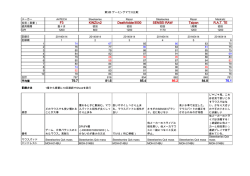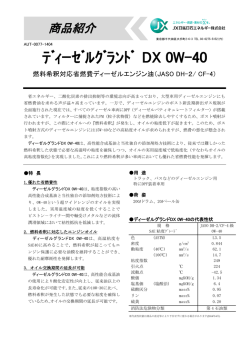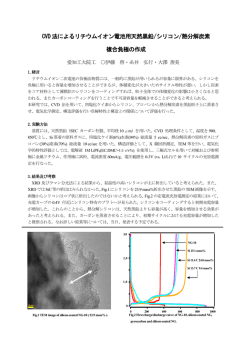
初代天体
細川 隆史 (東京大学) + final mass of the first stars and radia=ve feedback + the mass distribu=on of the first stars + origin of the supermassive black holes in the early universe 23.March.2014 SKA研究会@東大本郷 初期宇宙での星形成 ダークマターの大規模構造 CMB → 初期密度ゆらぎ the standard cosmology predicts when and where the first stars would form “mini-‐halo” (Tvir = 3000K) 星形成過程 v Large-‐structure forms via gravita=onal instability v Evolu=on of baryons: gas dynamics, chemistry, radia=ve processes… 初代星 初代星形成は初期条件の定まった星形成の問題 (well-‐defined!) 星形成のながれ Collapse(前期)段階 Accre=on(後期)段階 ガス雲が自己重力により収縮 原始星へ周囲からガスがふりつもる ガス雲質量: (free-‐fall =me = sound crossing =me) EOS: → γ<4/3のとき ρ↑⇒ MJ↓;不安定→collapse γは冷却過程による (初期宇宙ではH2分子線放射) 冷却効率がさがり (γ>4/3) 星の種(=原始星)が生まれる 原始星への降着率: ∝ T1.5 初代星形成の前期段階 始原ガス雲の重力崩壊 Yoshida, Omukai & Hernquist (2008), Science : self-‐similar “run-‐away “ collapse (e.g., Omukai & Nishi 98, Abel et al. 02) Time evolu=on of the density profile Zoom-‐up huge cloud:∼1000 M8 前期段階の進化は比較的 よく理解されている The “first” protostar:∼0.01 solar mass First Stars: How massive? 前期段階: collapse ⇒ 後期段階: accre=on Yoshida, Omukai & Hernquist (2008) Zoom-up “seed” protostar 10-‐2 M8 protostar surrounded by >103 M8 gas envelope 最終的な星の質量は質量降着 がいつまで続くかで決まる。 後期段階進化の研究が重要 後期段階の進化 予想される降着率: この降着率が維持されれば、星の寿命 ( Myr)間にもとのガス雲の質量全部 ⇒ が星に降り積もれる M* ∼ 1000M8 UV stellar feedback (e.g., McKee & Tan 08) 電離領域の形成 + 星周円盤の光蒸発 → M* ∼ 150M8? It has been postulated that the first stars were very massive (> 100 M8) Observational Challenge Abundance pakerns of the heavy elements generated in SN could be the observa=onal signature of the first stars The first stars end their lives with supernova explosion Stars born from the polluted gas have the same abundance pakerns as the supernova progenitors Galac=c metal-‐poor stars: Messenger from the early universe Heavy elements generated In the stellar interior are scakered No signatures of PISNe ( a few x 100M8). This prefers the ordinary massive stars which cause the CCSNe. Extremely Massive Stars: s=ll needed? bright QSOs at z > 6 with SMBH of > 109 M8 Age of the universe@z 7: 0.77Gyr. これまでに作る必要がある 非常に重い星が残す種BHから出発する方が都合がよい 超大質量星形成 ( 105M8) PopIII星形成の特殊なケース H atomic cooling H2 molecular ( Omukai 01) cooling La=f+13 ①水素分子が破壊されたハロー (e.g., 近くの星からの紫外光) ② H原始冷却による崩壊 (almost isothermal at T 8000K) ③急速なガス降着 (> 0.1M8/yr) による原始星の成長 ∝ T1.5 Rapid accre=on in cosmological simula=ons ④ GR不安定による星の崩壊 →105M8 BH Key Questions + What is the final mass of the first stars, resul=ng from the evolu=on in the accre=on phase? What is their mass distribu=on? + How does the stellar UV feedback halts the stellar growth via mass accre=on? Does the feedback always operate? + What is the maximum stellar mass? Is the forma=on of supermassive stars possible? Finally seeding SMBHs in the early universe? これらに答えるためには特に星質量が決まる後期段階の 進化研究が重要 2D輻射流体 + 星の進化計算 Hosokawa+11, 12 HII region T ρ + v Breakout of bipolar HII region toward polar direc=ons Dynamical expansion of the HII region Photoevapora=on of the disk (0.1Myr since the birth of the protostar) Acc. rate (M8/yr ) Accretion Histories No Feedback With Feedback Stellar mass (M8) Ø Acc. rate is significantly reduced by the stellar UV feedback Ø Mass accretion is shut off when the stellar mass is ∼43 M8 Stellar radius (R8 ) Protostellar Evolution Mass accre=on ceases soon a~er the protostar’s arrival to the zero-‐age main-‐sequence (ZAMS) ZAMS 2 characteris=c =mescales =mescale (yr ) * tKH Early:tKH>tacc ; adiabatic acc. tacc Adiaba=c acc. Kelvin-‐Helmholtz contrac=on Stellar mass (M8) Opacity↓ ⇒ L * ↑ ⇒ tKH↓ later: tKH<tacc ; K-H contraction Adiaba=c acc. K-‐H contrac=on K-‐H contrac=on stage luminosity↑ by releasing grav. energy of the star ZAMS + contrac=on (radius↓) Effec=ve temp.: Teff ↑ UV luminosity↑ Ionizing photon log number l uminosity (/sec ) Stellar radius (R8 ) Protostellar Evolution and feedback 30 Stellar mass (M8) UV feedback operates over late KH contrac=on → ZAMS stages, and finally stops the mass accre=on Forming 100 First stars Derive the mass distribu=on of the first stars following the evolu=on with 100 different star-‐forming clouds.(Hirano et al. 2014) dark halo mass & forma=on redshi~ with primordial star-‐forming clouds Mass Distribution bipolar HII regions stellar mass is fixed a~er the stellar UV feedback shuts off the mass accre=on lots of M* < 100 M8 stars, but also with M* > 100 M8 stars Diversity... why? With the higher acc. rates, + the stellar mass is higher + the star approaches the ZAMS stage at the higher stellar mass ( UV feedback works near the ZAMS stage) Rapid mass accre=on changes the stellar evolu=on With Very High Acc. Rates . radius ( R8 ) M < 0.06 M8/yr 0.5 ∝ M * rather relevant to forming the supermassive stars . radius ( R8 ) M > 0.06 M8/yr “supergiant protostar” stage with the rapid mass accre=on of > 0.01 M8/yr mass-‐radius rela=on: R*∝M*0.5 , which is independent of different mass accre=on rates stellar mass ( M8 ) Physics radius ( R8 ) M < 0.06 M8/yr + stellar luminosity: L* + radius ( R8 ) M > 0.06 M8/yr stellar mass ( M8 ) nearly constant effec=ve temperature Teff 5000K (strong T-‐dependence of H-‐ opacity) (ref. Hayashi track) good agreement with the numerical results Ionizing photon number luminosity (/sec) NO UV feedback rgi Supe osta t o r ant P r stellar mass (M8) Hosokawa et al. 2013 Ø low effec=ve temperature of < 104K → low UV luminosity Ø UV radia=ve feedback would not disturb the forma=on of supermassive stars . What controls M?: cloud mass & spin -‐ Weaker rota=on -‐ More massive gas cloud weak rota=on More rapid mass accre=on Higher stellar mass Diversity of the stellar masses comes from that of the gas clouds. massive cloud Diversity of the gas clouds comes from cosmology Hirano+14 in prep. (!) (第一世代) (第二世代) This is just beginning… 3D計算では重力不安定による円盤分裂も起こる Greif+13 円盤分裂により原始星 が複数できる ↓ 各々の原始星への降着率低下 (ガス雲の質量を分け合う) ↓ 最終的な星質量低下(?) どこまで高い分解能で長時間 進化を追えるかがchallenge (※分裂強度は分解能依存) 10AU 須佐計算 3D radia=ve SPH + 原始星進化tracks (Hosokawa & Omukai 09) 104 AU 水素分子のアバンダンス t=1160yr Susa+14 in prep. t=5120yr Susa 13 星のFUV光による水素分子破壊のfeedback おそらく円盤分裂の効果により Hirano+14よりやや低質量側にシフト My 3D test case + UV feedback (星の進化は今回はcoupleせず) 星質量が30M8に達したらTeff=105K, L*=106L8で光らせる T n 星質量増加 星質量 (M8) Feedbackなし Feedbackあり 時間 (年) + Feedbackによりじょじょに質量降着が阻害されている (光蒸発) + 星がちゃんと光れば3Dでも光電離によるfeedbackが起こる + このケースは円盤分裂は起こらず 円盤分裂が起きた別ケース + 中心星に落下して合体 + 分裂が起きても必ずしも星質量が下がるとは限らない 円盤分裂と星最終質量 一度分裂した後、再度の合体がどのくらいの頻度で起きるかが鍵 Greif+13 およそ2/3程度の分裂片は合体 残りはejec=onされるなどで生存 (※この例は分解能が高いかわりに最初の10年間だけ) Summary How massive were the first stars? + Lots of “ordinary” massive stars, which are M*< 100 M8 but still with a number of M* > 100M8 stars + Rapid mass accretion changes the protostellar evolution, which is helpful for forming very massive stars. Future Prospects + 3D effects (e.g., disk fragmentation v.s. stellar merger) reduce or increase the final mass? + what about second or later generations of Pop III stars? (e.g., Hosokawa+12; Hirano+14 in prep.)
© Copyright 2025


